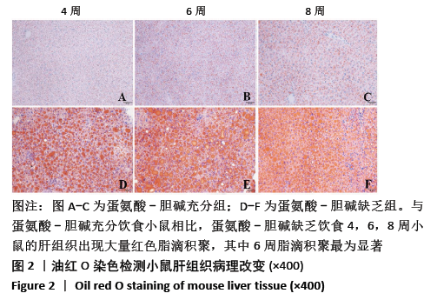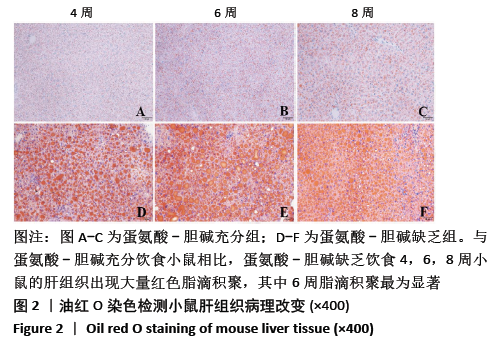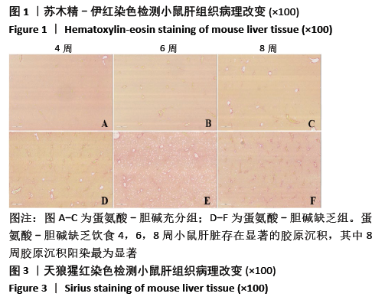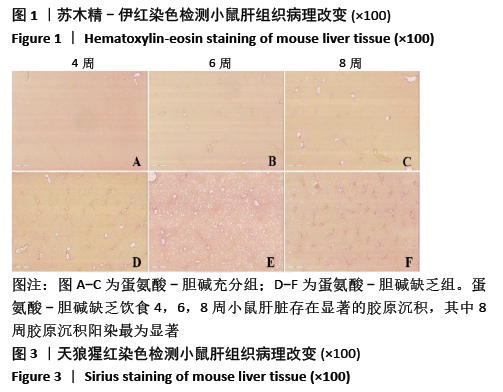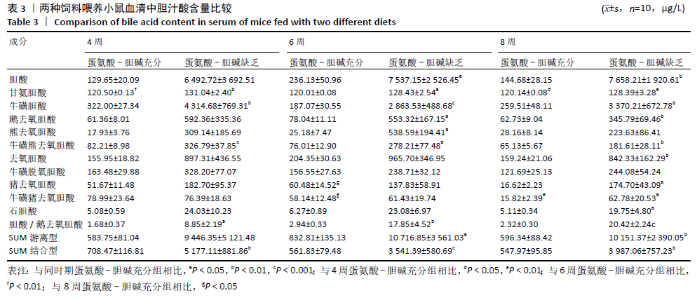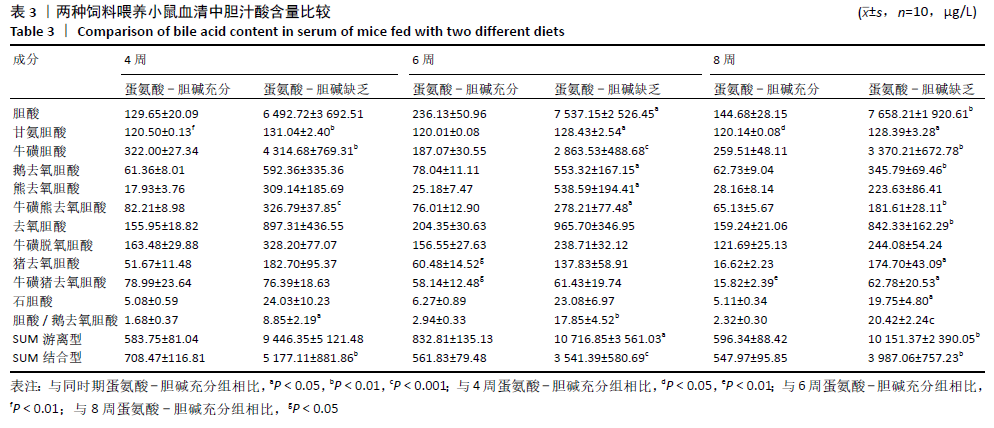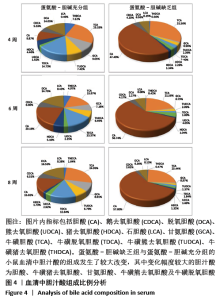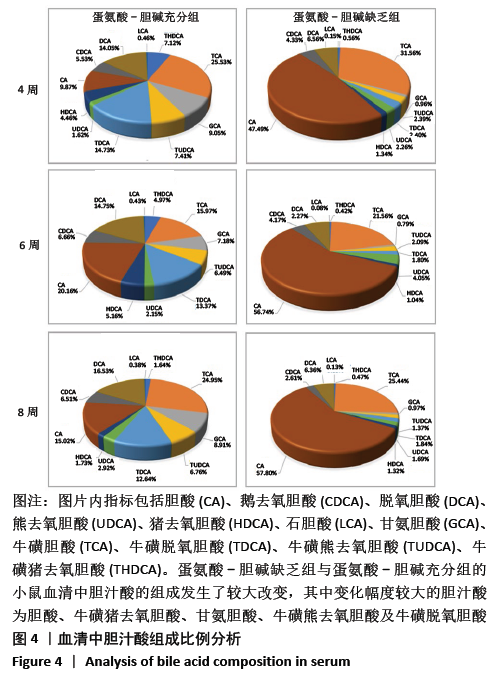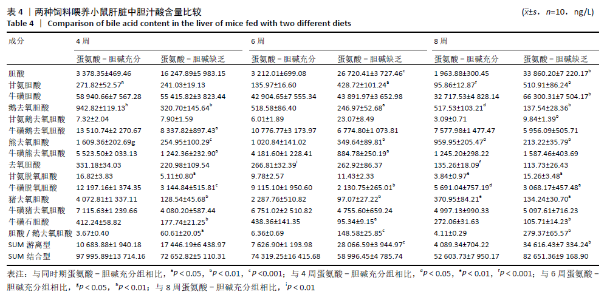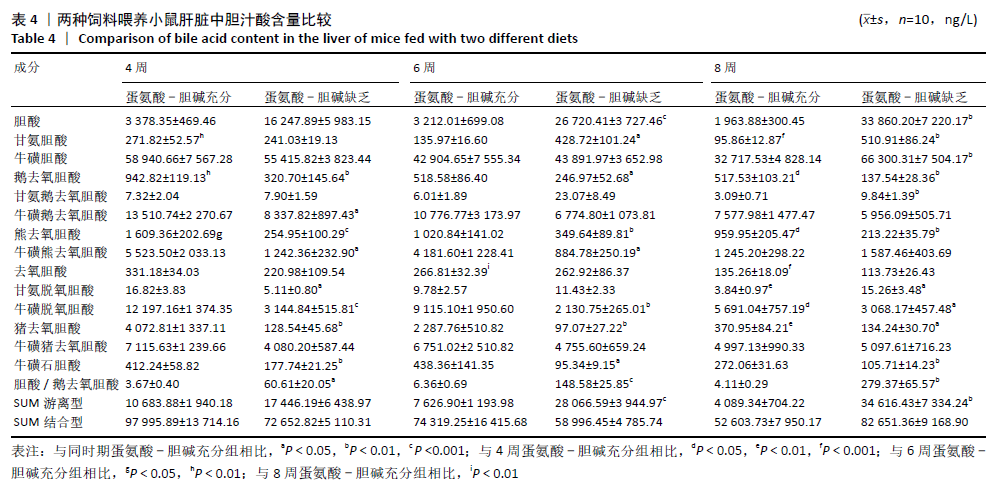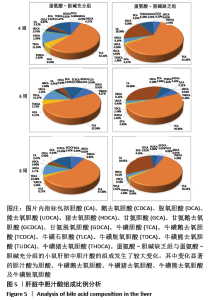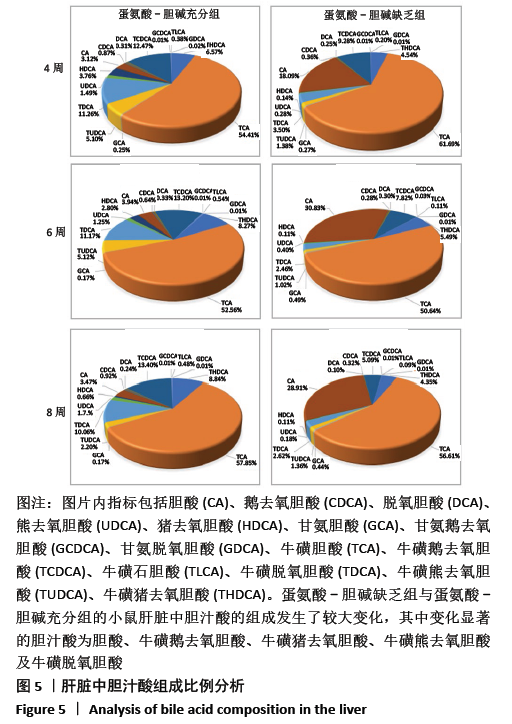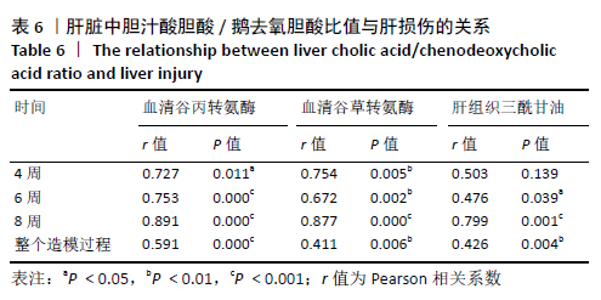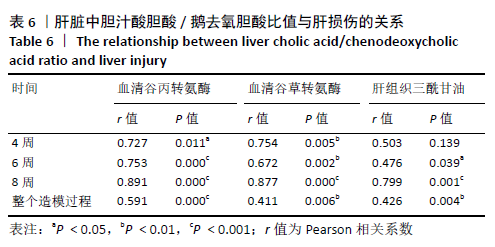Chinese Journal of Tissue Engineering Research ›› 2021, Vol. 25 ›› Issue (26): 4137-4144.doi: 10.12307/2021.111
Previous Articles Next Articles
Changes of serum and liver bile acid profiles in a mouse model of metabolic associated fatty liver disease induced by a methionine-choline-deficient diet
Yang Hailin1,2,3, Zhang Dingqi1,2,3, Chen Gaofeng1,2,3, Zhang Congcong4, Chen Jiamei1,2,3, Wang Xiaoning5, Liu Wei1,2,3, Liu Ping1,2,3,5
- 1Institute of Liver Diseases, 2Shanghai Key Laboratory of Traditional Chinese Medicine, Shuguang Hospital, Shanghai University of Traditional Chinese Medicine, Shanghai 201203, China; 3Liver and Kidney Diseases Key Laboratory of Ministry of Education, 4Institute of Chinese Materia Medica,5Institute of Interdisciplinary Science, Shanghai University of Traditional Chinese Medicine, Shanghai 201203, China
-
Received:2020-08-07Revised:2020-08-11Accepted:2020-09-17Online:2021-09-18Published:2021-04-26 -
Contact:Liu Ping, MD, Professor, Institute of Liver Diseases, Shuguang Hospital, Shanghai University of Traditional Chinese Medicine, Shanghai 201203, China; Shanghai Key Laboratory of Traditional Chinese Medicine, Shuguang Hospital, Shanghai University of Traditional Chinese Medicine, Shanghai 201203, China; Liver and Kidney Diseases Key Laboratory of Ministry of Education, Shanghai University of Traditional Chinese Medicine, Shanghai 201203, China; Institute of Interdisciplinary Science, Shanghai University of Traditional Chinese Medicine, Shanghai 201203, China Liu Wei, MD, Associate researcher, Institute of Liver Diseases, Shuguang Hospital, Shanghai University of Traditional Chinese Medicine, Shanghai 201203, China; Shanghai Key Laboratory of Traditional Chinese Medicine, Shuguang Hospital, Shanghai University of Traditional Chinese Medicine, Shanghai 201203, China; Liver and Kidney Diseases Key Laboratory of Ministry of Education, Shanghai University of Traditional Chinese Medicine, Shanghai 201203, China E-mail:liuliver@vip.sina.com;lwhzayl@shutcm.edu.cn -
About author:Yang Hailin, Master candidate, Institute of Liver Diseases, Shuguang Hospital, Shanghai University of Traditional Chinese Medicine, Shanghai 201203, China; Shanghai Key Laboratory of Traditional Chinese Medicine, Shuguang Hospital, Shanghai University of Traditional Chinese Medicine, Shanghai 201203, China; Liver and Kidney Diseases Key Laboratory of Ministry of Education, Shanghai University of Traditional Chinese Medicine, Shanghai 201203, China -
Supported by:the National Natural Science Foundation of China, No. 81703681 (to LW) and 81530101 (to LP); Shanghai Sailing Plan for Scientific Youth Talents, No. 17YF1419800 (to LW)
CLC Number:
Cite this article
Yang Hailin, Zhang Dingqi, Chen Gaofeng, Zhang Congcong, Chen Jiamei, Wang Xiaoning, Liu Wei, Liu Ping. Changes of serum and liver bile acid profiles in a mouse model of metabolic associated fatty liver disease induced by a methionine-choline-deficient diet[J]. Chinese Journal of Tissue Engineering Research, 2021, 25(26): 4137-4144.
share this article
Add to citation manager EndNote|Reference Manager|ProCite|BibTeX|RefWorks
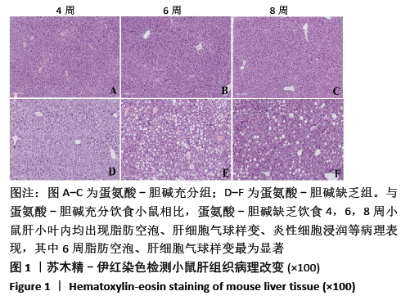
2.1 实验动物数量分析 共纳入小鼠60只,随机分为6组,均进入结果分析,无脱失。 2.2 动物行为学及病理评分结果 实验期间各组动物均无死亡,蛋氨酸-胆碱充分组小鼠毛发柔顺、有光泽、精神状态良好。蛋氨酸-胆碱缺乏组小鼠随喂养时间增长,表现为体质量明显减轻,毛发紊乱、无光泽,活动减弱,精神萎靡。 苏木精-伊红染色结果(图1)显示:蛋氨酸-胆碱充分喂养小鼠肝小叶结构均基本正常,肝板走行整齐,肝细胞索排列整齐清晰,围绕中央静脉呈放射状排列,肝细胞形状规则,排列致密、均一,细胞核呈圆形;蛋氨酸-胆碱缺乏喂养4周组小鼠肝细胞肿胀呈圆形,体积较正常明显增加,胞质内可见脂肪空泡,其中汇管区和小叶内可见炎性细胞浸润;蛋氨酸-胆碱缺乏喂养6周组肝细胞呈大泡性脂肪变,小叶内可见灶状肝细胞坏死,伴有淋巴细胞和中性粒细胞浸润,并逐渐出现肝纤维化表现;蛋氨酸-胆碱缺乏喂养8周组肝小叶内脂肪空泡、肝细胞气球样变、炎性细胞灶性浸润并存,肝纤维化表现加重。"
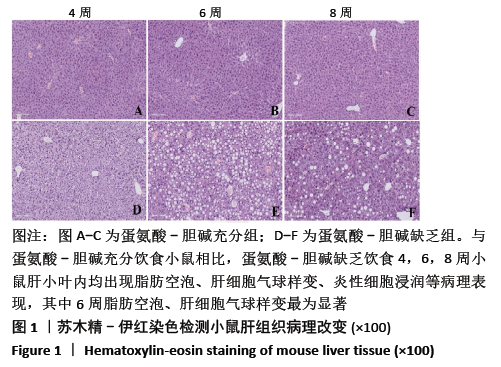
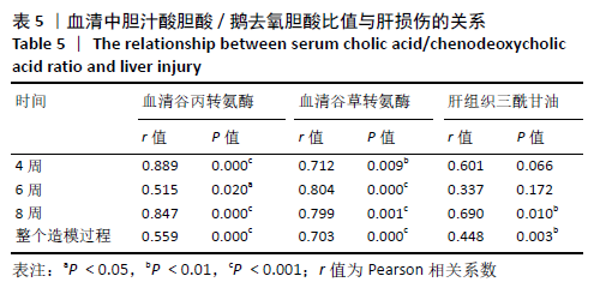
从小鼠血清胆汁酸检测结果可以看出,与蛋氨酸-胆碱充分组小鼠相比,蛋氨酸-胆碱缺乏组小鼠血清中总游离型和总结合型胆汁酸以及除牛磺脱氧胆酸外的胆汁酸,含量均呈上升趋势,胆酸/鹅去氧胆酸值显著升高;随着饲养时间增长,蛋氨酸-胆碱充分组胆汁酸含量猪去氧胆酸、甘氨胆酸、牛磺猪去氧胆酸含量显著下降;如图4所示,蛋氨酸-胆碱缺乏组与蛋氨酸-胆碱充分组的小鼠血清中胆汁酸的组成发生了较大改变,其中变化幅度较大的胆汁酸为胆酸、牛磺猪去氧胆酸、甘氨胆酸、牛磺熊去氧胆酸、牛磺脱氧胆酸等。发现造模4,6,8周时,与蛋氨酸-胆碱充分组胆酸占比(9.87%,20.16%,15.02%)相比,在蛋氨酸-胆碱缺乏组的占比(47.49%,56.74%,57.80%)分别增加了4.8,2.8,3.8倍;与蛋氨酸-胆碱充分组牛磺猪去氧胆酸占比(7.12%,4.97%,1.64%)相比,在蛋氨酸-胆碱缺乏组的占比(0.56%,0.42%,0.47%)降低了92%,92%,72%;与蛋氨酸-胆碱充分组甘氨胆酸占比(9.05%,7.18%,8.91%)相比,在蛋氨酸-胆碱缺乏组的占比(0.96%,0.79%,0.97%)降低了90%,89%,89%;与蛋氨酸-胆碱充分组牛磺熊去氧胆酸占比(7.41%,6.49%,6.76%)相比,在蛋氨酸-胆碱缺乏组的占比(2.39%,2.09%,1.37%)降低了68%,68%,80%;与蛋氨酸-胆碱充分组牛磺脱氧胆酸占比(14.73%,13.37%,12.64%)相比,在蛋氨酸-胆碱缺乏组的占比(2.40%,1.80%,1.84%)降低了84%,87%,86%。 从小鼠肝脏胆汁酸检测结果可以看出,与蛋氨酸-胆碱充分组小鼠相比,蛋氨酸-胆碱缺乏组肝脏中总游离型胆汁酸以及胆汁酸胆酸、甘氨胆酸、甘氨鹅去氧胆酸、牛磺胆酸含量呈上升趋势,胆汁酸鹅去氧胆酸、熊去氧胆酸、猪去氧胆酸、牛磺熊去氧胆酸、牛磺石胆酸、牛磺鹅去氧胆酸、牛磺脱氧胆酸含量呈下降趋势,胆汁酸甘氨脱氧胆酸含量呈先下降后上升趋势,胆汁酸去氧胆酸、牛磺猪去氧胆酸含量基本不变,胆酸/鹅去氧胆酸值显著升高;随着饲养时间增长,蛋氨酸-胆碱充分组胆汁酸鹅去氧胆酸、熊去氧胆酸、去氧胆酸、猪去氧胆酸、甘氨胆酸、甘氨脱氧胆酸、牛磺脱氧胆酸含量显著下降;如图5所示,蛋氨酸-胆碱缺乏组小鼠肝脏中胆汁酸的组成发生了较大变化,其中变化显著的为胆酸、牛磺鹅去氧胆酸、牛磺猪去氧胆酸、牛磺熊去氧胆酸、牛磺脱氧胆酸。发现造模4,6,8周时,与蛋氨酸-胆碱充分组胆酸占比(3.12%,3.94%,3.47%)相比,在蛋氨酸-胆碱缺乏组的占比(18.09%,30.83%,28.91%)增加了5.8,7.8,8.3倍;与蛋氨酸-胆碱充分组牛磺鹅去氧胆酸占比(12.47%,13.20%,13.40%)相比,在蛋氨酸-胆碱缺乏组的占比(9.28%,7.82%,5.09%)降低了26%,41%,63%;与蛋氨酸-胆碱充分组牛磺猪去氧胆酸占比(6.57%,8.27%,8.84%)相比,在蛋氨酸-胆碱缺乏组的占比(4.54%,5.49%,4.35%)降低了31%,34%,51%;与蛋氨酸-胆碱充分组牛磺熊去氧胆酸占比(5.10%,5.12%,2.20%)相比,在蛋氨酸-胆碱缺乏组的占比(1.38%,1.02%,1.36%)降低了73%、81%、39%;与蛋氨酸-胆碱充分组牛磺脱氧胆酸占比(11.26%,11.17%,10.06%)相比,在蛋氨酸-胆碱缺乏组的占比(3.50%,2.46%,2.62%)降低了69%,78%,74%。 此外,将血清及肝脏中胆汁酸胆酸/鹅去氧胆酸比值与肝损伤相关的生化指标(血清谷丙转氨酶、谷草转氨酶及肝组织三酰甘油)作Pearson相关分析,结果见表5,6。表中相关系数为正值说明呈正相关,表示随着肝损伤的增强胆酸/鹅去氧胆酸比值升高,相关系数的绝对值越大代表相关性越强。可以看出,4,6,8周小鼠血清中胆酸/鹅去氧胆酸比值与血清谷丙转氨酶、谷草转氨酶活性呈正相关(P < 0.05),8周小鼠血清中胆酸/鹅去氧胆酸比值与肝组织三酰甘油含量呈正相关(P < 0.01),且整个造模过程中的小鼠血清中胆酸/鹅去氧胆酸比值与血清谷丙转氨酶、谷草转氨酶活性及肝组织三酰甘油含量呈正相关(P < 0.01)。4,6,8周小鼠肝脏中胆酸/鹅去氧胆酸比值与血清谷丙转氨酶、谷草转氨酶活性呈正相关(P < 0.05),6,8周小鼠肝脏中胆酸/鹅去氧胆酸比值与肝组织三酰甘油含量呈正相关(P < 0.05),且整个造模过程中的小鼠肝脏中胆酸/鹅去氧胆酸比值与血清谷丙转氨酶、谷草转氨酶活性及肝组织三酰甘油含量呈正相关(P < 0.01)。"
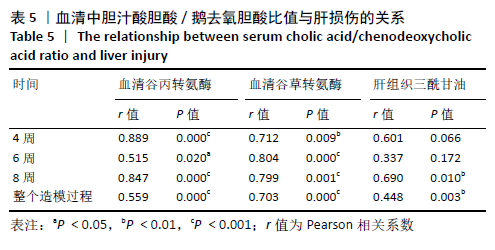
| [1] ESLAM M, NEWSOME PN, SARIN SK, et al. A new definition for metabolic dysfunction-associated fatty liver disease: An international expert consensus statement. J Hepatol. 2020;73(1):202-209. [2] GEISLER CE, RENQUIST BJ. Hepatic lipid accumulation: cause and consequence of dysregulated glucoregulatory hormones. J Endocrinol. 2017;234(1):R1-R21. [3] AKBAR S, PINCON A, LANHERS MC, et al. Expression profile of hepatic genes related to lipid homeostasis in LSR heterozygous mice contributes to their increased response to high-fat diet. Physiol Genomics. 2016;48(12):928-935. [4] RINELLA ME. Nonalcoholic fatty liver disease: a systematic review. JAMA. 2015; 313(22):2263-2273. [5] CHIANG JYL, FERRELL JM. Bile Acid Metabolism in Liver Pathobiology. Gene Expr. 2018;18(2):71-87. [6] CHIANG JYL. Bile acid metabolism and signaling. Compr Physiol. 2013;3(3):1191-1212. [7] LEFEBVRE P, CARIOU B, LIEN F, et al. Role of bile acids and bile acid receptors in metabolic regulation. Physiol Rev. 2009;89(1):147-191. [8] KUNDU S, KUMAR S. Cross-talk between bile acids and gastrointestinal tract for progression and development of cancer and its therapeutic implications. IUBMB Life. 2015;67(7):514-523. [9] IBTAHIM SH, HIRSOVA P, MALHI H, et al. Animal Models of Nonalcoholic Steatohepatitis: Eat, Delete, and Inflame. Dig Dis Sci. 2016;61(5):1325-1336. [10] YANG L, XIONG AZ, HE YQ, et al. Bile acids metabonomics study on the CCl4 and alpha-naphthylisothiocyanate-induced animal models: quantitative analysis of 22 bile acids by ultraperformance liquid chromatography-mass spectrometry. Chem Res Toxicol. 2008;21(12):2280-2288. [11] ANSTEE QM. Mouse models in non-alcoholic fatty liver disease and steatohepatitis research. Int J Exp Pathol. 2006;87(1):1-16. [12] GYAMFI MA, DAMJANOV I, FRENCH S, et al. The pathogenesis of ethanol versus methionine and choline deficient diet-induced liver injury. Biochem Pharmacol. 2008;75(4):981-995. [13] LAU JK, ZHANG X. Animal models of non-alcoholic fatty liver disease: current perspectives and recent advances. J Pathol. 2017;241(1):36-44. [14] YAMADA T, OBATA A, KASHIWAGI Y, et al. Gd-EOB-DTPA-enhanced-MR imaging in the inflammation stage of nonalcoholic steatohepatitis (NASH) in mice. Magn Reson Imaging. 2016;34(6):724-729. [15] 范建高,王国良.脂肪肝与肝纤维化[J].肝脏,1999,4(2):3-5. [16] SUN R, YANG N, KONG B, et al. Orally Administered Berberine Modulates Hepatic Lipid Metabolism by Altering Microbial Bile Acid Metabolism and the Intestinal FXR Signaling Pathway. Mol Pharmacol. 2017;91(2):110-122. [17] JIA W, XIE G. Bile acid-microbiota crosstalk in gastrointestinal inflammation and carcinogenesis. Nat Rev Gastroenterol Hepatol. 2018;15(2):111-128. [18] CHIANG JY. Regulation of bile acid synthesis: pathways, nuclear receptors, and mechanisms. J Hepatol. 2004;40(3):539-551. [19] CHOW MD, LEE YH. The role of bile acids in nonalcoholic fatty liver disease and nonalcoholic steatohepatitis. Mol Aspects Med. 2017;56:34-44. [20] JONES H, ALPINI G. Bile acid signaling and biliary functions. Acta Pharm Sin B. 2015;5(2):123-128. [21] 张久聪, 聂青和. 胆汁酸代谢及相关进展[J]. 胃肠病学和肝病学杂志,2008, 17(11): 953-956. [22] HOFMANN AF, HAGEY LR. Bile acids: chemistry, pathochemistry, biology, pathobiology, and therapeutics. Cell Mol Life Sci. 2008;65(16):2461-2483. [23] 黄延风, 朱朝敏. 胆汁酸的毒性作用[J]. 国际检验医学杂志,2006,27(2): 152-153+157. [24] THOMAS C, PELLICCIARI R, PRUZANSKI M, et al. Targeting bile-acid signalling for metabolic diseases. Nat Rev Drug Discov. 2008;7(8):678-693. [25] MONTE MJ, MARIN JJ, ANTELO A, et al. Bile acids: chemistry, physiology, and pathophysiology. World J Gastroenterol. 2009;15(7):804-816. [26] XIE G, WANG X, HUANG F, et al. Dysregulated hepatic bile acids collaboratively promote liver carcinogenesis. Int J Cancer. 2016;139(8):1764-1775. [27] LU Y, DU Y, QIN L, et al. Gypenosides Altered Hepatic Bile Acids Homeostasis in Mice Treated with High Fat Diet. Evid Based Complement Alternat Med. 2018;2018:8098059. |
| [1] | Qiao Xuesong, Chen Ni, Yang Fengying, Niu Yanmei. Exercises regulate bone marrow adipocytes derived from mesenchymal stem cells: roles and prospects [J]. Chinese Journal of Tissue Engineering Research, 2020, 24(8): 1293-1298. |
| [2] | Ma Fang, Zhang Hui, Li Guizhong, Ma Shengchao, Shen Jiangyong, Sun Lei, Hao Yinju, Ma Shengxian, Jiang Yideng. Involvement of miR-148a-5p in ApoE-/- mouse hepatocyte apoptosis induced by high methionine diet [J]. Chinese Journal of Tissue Engineering Research, 2020, 24(35): 5632-5637. |
| [3] |
Li Ying, Lin Wentao, Weng Xiquan.
Effects of different exercise intensities on visfatin level and glucose metabolism in type 2 diabetic rats [J]. Chinese Journal of Tissue Engineering Research, 2020, 24(26): 4196-4200. |
| [4] | Society for Prevention and Control of Tissue Inflammation and Injury of Chinese Preventive Medicine Association, Society of Parenteral and Enteral Nutrition of Chinese Medical Association, Diabetic Foot Group, Committee of Peripheral Vascular Disease, China Society of Integrated Traditional Chinese and Western Medicine. Medical nutrition treatment guideline for diabetic foot [J]. Chinese Journal of Tissue Engineering Research, 2019, 23(35): 5682-5689. |
| [5] | Chen Jun, Tang Jing, Chen Buyu. Feasibility of laboratory-related indicators in predicting clinical outcome of liver failure [J]. Chinese Journal of Tissue Engineering Research, 2019, 23(23): 3734-3738. |
| [6] | Zhao Dalin1, Li Jing1, Ma Tie1, Gao Haining1, Liu Haopeng1, Zhang Shicheng1, Xu Sitong1, Xiao Jiayu1, Li Yiran1, Yan Shengnan1, Chang Bo1, 2. Changes of phosphoinositide 3-kinase-protein kinase B signaling pathway in skeletal muscle of type 2 diabetes rat models after 8-week aerobic exercise [J]. Chinese Journal of Tissue Engineering Research, 2019, 23(23): 3660-3666. |
| [7] | Li Xiao, Zhang Xin-sheng, Luo Hai-jie, Luan Shuo, Wan Qing, Wu Shao-ling, Ma Chao . Growth and secretion features of microencapsulated human adrenal pheochromocytoma cells in artificial cerebrospinal fluid [J]. Chinese Journal of Tissue Engineering Research, 2015, 19(38): 6114-6120. |
| [8] | Xing Hong-xia, Yuan Yan, Liu Sheng, Yin Chuang, Han Jin-hong, Zhou Hui-cong, Su Zhou, Guo Shuang-xi, Wang Yu-mei. Relationship between learning and memory capacities and levodopa in rat models of Parkinson’s disease [J]. Chinese Journal of Tissue Engineering Research, 2014, 18(7): 1069-1075. |
| [9] | Zhang Ben, Gong De-jun, Zhang Xi-wu, Xu Tong-yi, Han Lin, Tang Hao, Lu Fang-lin, Xu Zhi-yun. Phosphorylcholine coating enhances biocompatibility of expanded polytetrafluoroethylene used in polymeric prosthetic heart valves [J]. Chinese Journal of Tissue Engineering Research, 2014, 18(34): 5509-5514. |
| [10] | Gao Yin-jie, Liu Zhen-wen, Zhang Min, Su Hai-bin, Zhou Shuang-nan, Zhou Xia, Zhang Da-li, He Xi, Tang Ru-jia. Entecavir combined with immunoglobulin prevents hepatitis B recurrence after liver transplantation [J]. Chinese Journal of Tissue Engineering Research, 2013, 17(31): 5588-5594. |
| [11] | Wang Fang, Li Yong, Su Ying-jun, Wang Na, Xu Chen, Zhou Bo. Application of low-dose insulin in diabetes refractory wound healing: Epithelialization, collagen deposition and angiogenesis [J]. Chinese Journal of Tissue Engineering Research, 2013, 17(20): 3650-3657. |
| [12] | Wang Shun-li, Shi Reng-fei. Protein synthesis and resistance in aging skeletal muscle [J]. Chinese Journal of Tissue Engineering Research, 2013, 17(15): 2835-2842. |
| [13] | Deng Chun-ying, Liu Bin, Zhang Zhi-yong, Zhang Yu-qin, Li Yan, Yi Hong-li. Adipose-derived stromal cells differentiate into cholinergic neurons [J]. Chinese Journal of Tissue Engineering Research, 2013, 17(1): 44-49. |
| Viewed | ||||||
|
Full text |
|
|||||
|
Abstract |
|
|||||
